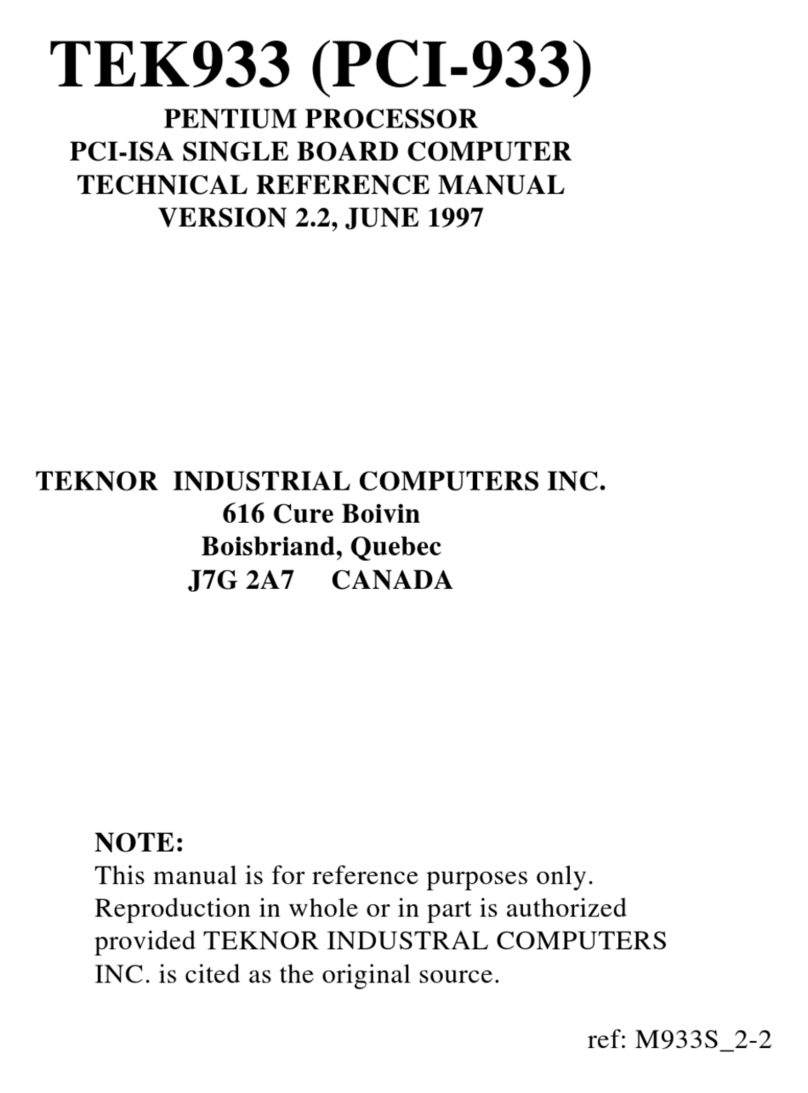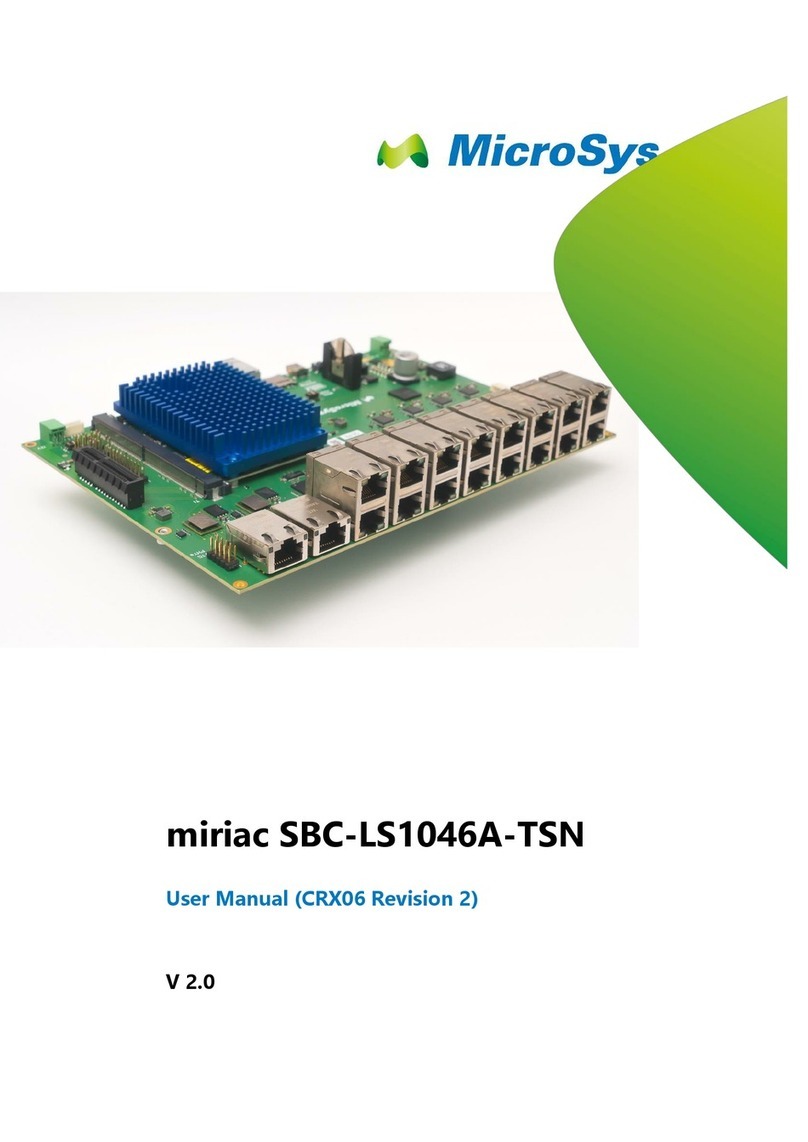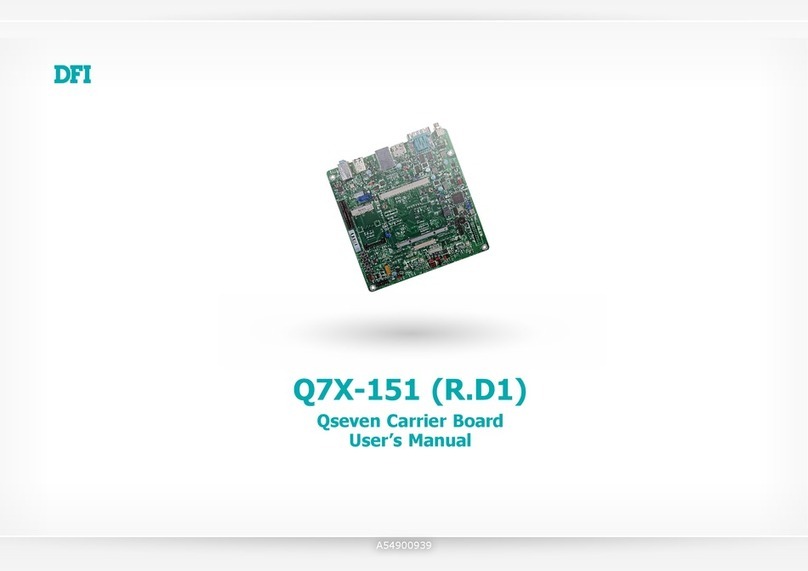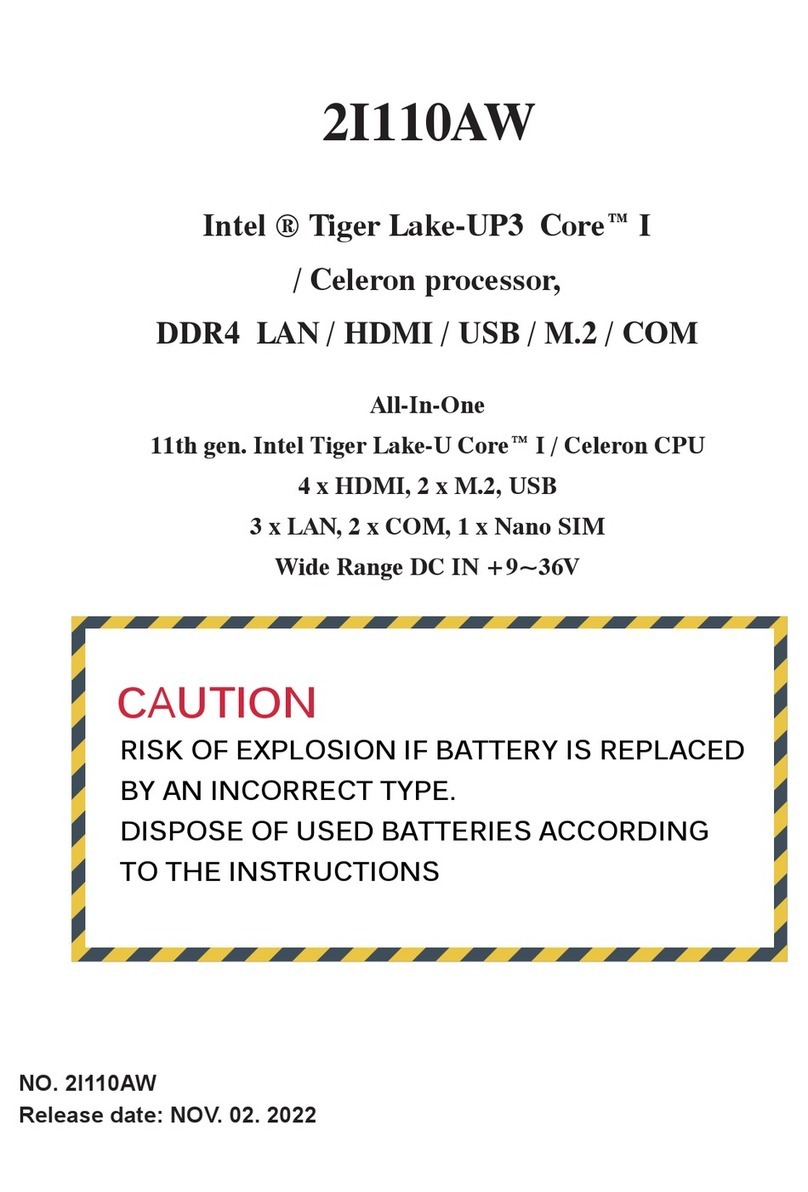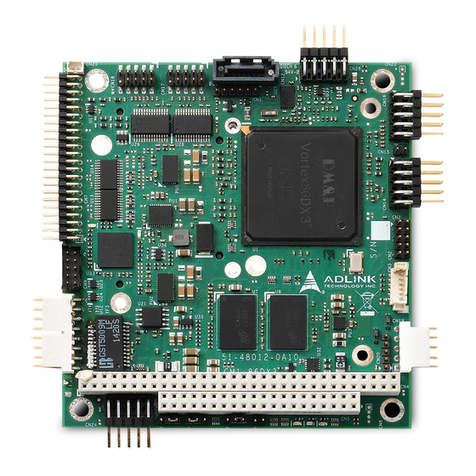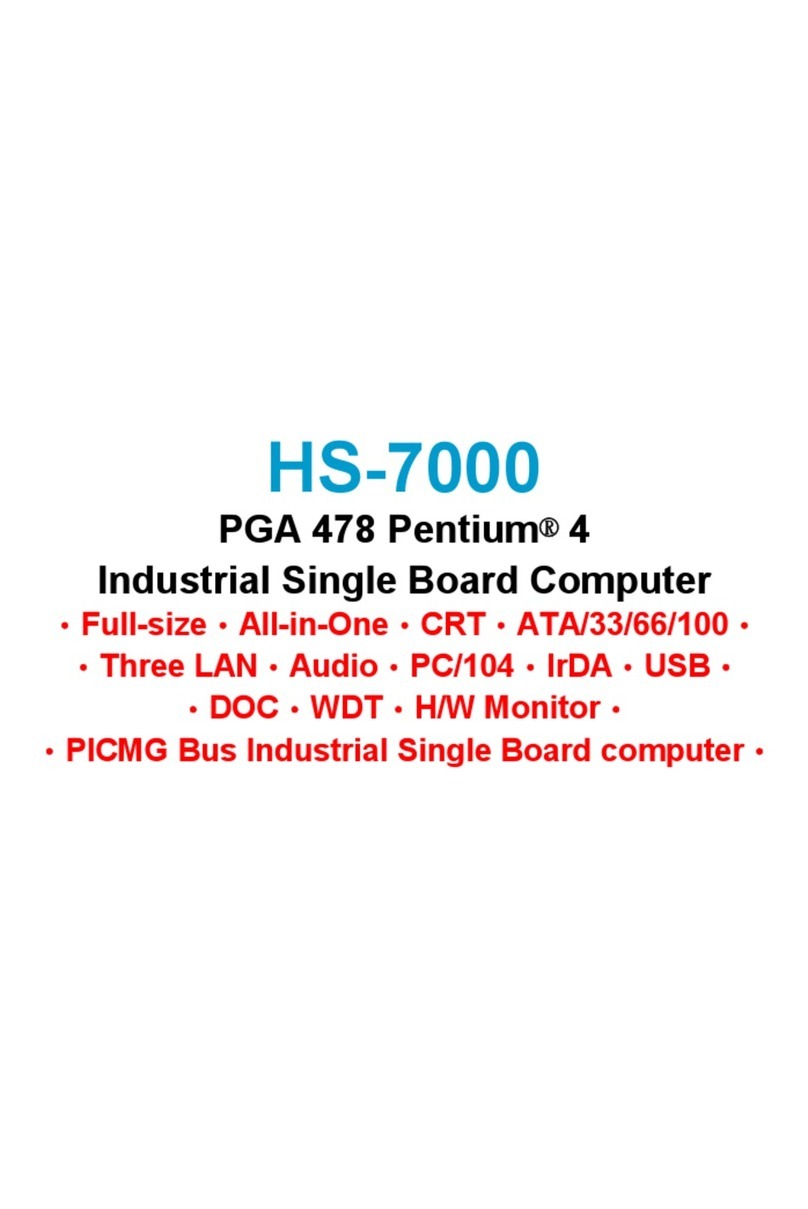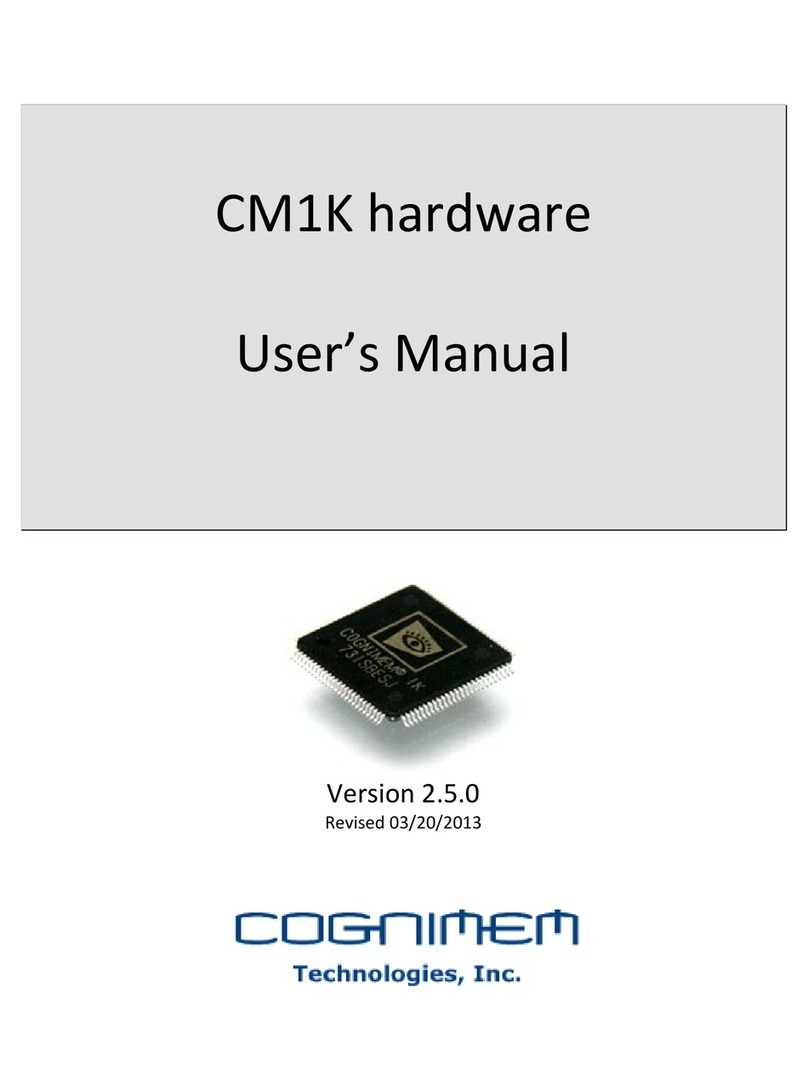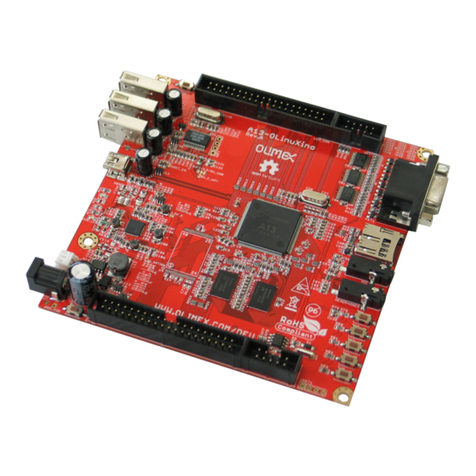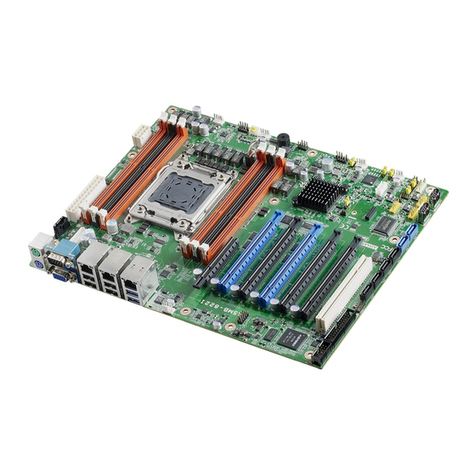Teknor Industrial Computers VIPer808 Product manual

VIPer808
486/5x86 PROCESSOR
INDUSTRIAL SINGLE BOARD COMPUTER
TECHNICAL REFERENCE MANUAL
VERSION 1.2, MARCH 1997
TEKNOR INDUSTRIAL COMPUTERS INC.
616 Cure Boivin
Boisbriand, Quebec
J7G 2A7 CANADA
NOTE:
This manual is for reference purposes only.
Reproduction in whole or in part is authorized
provided TEKNOR INDUSTRIAL COMPUTERS INC.
is cited as the original source.
ref: M808S_1-2

iii
FOREWORD
The information in this document is provided for reference purposes only. TEKNOR does
not assume any liability for the application of information or the use of products described
herein.
This document may contain information or refer to products protected by the copyrights or
patents of others and does not convey any license under the patent rights of TEKNOR, nor
the rights of others.
Printed in Canada.
Copyright 1997 by TEKNOR INDUSTRIAL COMPUTERS INC., Boisbriand, Qc J7G
2A7.

v
TABLE OF CONTENTS
LIST OF DIAGRAMS x
LIST OF TABLES xi
READ ME FIRST 1
INTRODUCTION 1
PART ONE
INSTALLING & SETTING UP VIPer
SECTION 1
INSTALLATION & SETUP 1-1
1.01 GETTING STARTED 1-1
1.02 HOW THE BOARD CAN BE USED 1-2
1.03 IMPORTANT PRECAUTIONS WHEN WORKING WITH A BOARD 1-3
1.04 UNPACKING 1-4
SECTION 2
INSTALLING MEMORY 2-1
2.01 TYPES OF MEMORY ON BOARD 2-1
2.02 SIMM CONFIGURATION & INSTALLATION 2-7
SECTION 3
SETTING JUMPERS 3-1
3.01 TERMINOLOGY 3-1
3.02 JUMPER LOCATIONS ON THE BOARD 3-1
3.03 JUMPER SETTINGS 3-5

vi
SECTION 4
INSTALLING & WORKING WITH SYSTEM COMPONENTS 4-1
4.01 MICROPROCESSOR & FAN 4-1
4.02 CONFIGURING CACHE 4-3
4.03 SYSTEM CONTROLLER OVERVIEW 4-4
4.04 MULTI-FUNCTION CONNECTOR
(KEYBOARD, SPEAKER, RESET & LED) 4-6
4.05 PC/104 EXPANSION CARDS 4-7
4.06 PS/2 MOUSE 4-7
SECTION 5
INSTALLING PERIPHERALS (PARALLEL/SERIAL/ETHERNET) 5-1
5.01 PARALLEL PORT 5-1
5.02 SERIAL PORTS 5-6
5.03 ETHERNET PORT 5-10
SECTION 6
INSTALLING IDE & FLOPPY DEVICES 6-1
6.01 INSTALLING IDE DEVICES 6-1
6.02 INSTALLING FLOPPY DEVICES 6-5
SECTION 7
INSTALLING VIDEO 7-1
7.01 CRT SVGA CONTROLLER 7-1
7.02 CONNECTING CRT VIDEO DISPLAY 7-2

vii
SECTION 8
POWER MANAGEMENT 8-1
8.01 POWER SUPPLY SOURCE 8-1
8.02 POWER MANAGEMENT MODES 8-2
8.03 RESET CIRCUIT 8-3
8.04 POWER FAIL DETECTION CIRCUIT 8-4
8.05 WATCHDOG TIMER 8-6
SECTION 9
VIPer SOFTWARE SETUP 9-1
9.01 AMIBIOS SETUP PROGRAM 9-2
9.02 UPDATING OR RESTORING BIOS IN BOOT-BLOCK FLASH 9-16

viii
APPENDICES
APPENDIX A
VIPer808 SPECIFICATIONS A-1
A.01 SPECIFICATIONS A-1
A.02 BATTERY A-3
A.03 MTBF (MEAN TIME BETWEEN FAILURES) A-4
A.04 MEETING INDUSTRY STANDARDS A-6
APPENDIX B
MEMORY & I/O MAPS B-1
B.01 MEMORY MAPS B-1
B.02 I/O MAPS B-3
APPENDIX C
MECHANICAL LAYOUT & BLOCK DIAGRAM C-1
APPENDIX D
CONNECTOR PINOUTS D-1
APPENDIX E
RECOMMENDED DEVICES & MATING CONNECTORS E-1
APPENDIX F
ERROR CODES F-1
F.01 POST CODES F-1
F.02 WORD CHECK-POINTS F-8
F.03 BEEP ERROR CODES F-9
GETTING HELP 1

ix
LIST OF DIAGRAMS
2-1: Assembly (Top) 2-3
2-2: Assembly (Bottom) 2-5
3-1: VIPer808 Jumper Locations with Default Settings 3-3
6-1: Floppy Disk Cable 6-7
7-1: VIPer808 Connector Locations 7-3
B-1: Memory Map Diagram B-1
C-1: Mechanical Specifications C-3
C-2: Block Diagram VIPer808 C-5

x
LIST OF TABLES
2-1: SIMM Configuration 2-8
3-1a: Jumper Settings: W1, W4, W13, W14 3-6
3-1b: AMD DX2-DX4 CPU Jumper Settings: W1, W15-W15C 3-7
3-1c: AMD 5x86 CPU Jumper Settings: W1, W15-W15C 3-8
3-1d: Intel CPU Jumper Settings: W1, W15-W15C 3-9
3-1e: SGS CPU Jumper Settings: W1, W15-W15C 3-10
3-1f: Jumper Settings: W18, W20-W23 3-11
4-1: 8237 DMA Controllers 4-4
4-2: 8259 Interrupt Controllers 4-5
4-3: Keyboard / Speaker Connector(J3) 4-6
5-1: Printer Parallel Port (J13) - Standard Mode 5-2
5-2: Printer Parallel Port (J13) - EPP Mode 5-3
5-3: Printer Parallel Port (J13) - ECP Mode 5-4
5-4a: Serial Port 1 (J7) RS-232 5-7
5-4b: IBM 9-Pin DSUB Standard 5-7
5-5a: Serial Port 2 (J4) RS-232 5-8
5-5b: IBM 9-Pin DSUB Standard 5-8
5-6: Ethernet 10 Base-T RJ45 Connector (J14) - Pinout 5-12

xi
LIST OF TABLES (Continued)
6-1: IDE Hard Disk Connector (J1) - Pinout 6-2
6-2: Floppy Connector (J2) - Pinout 6-6
7-1: SVGA Connector (J12) - Pinout 7-2
8-1: External Power Connector (J9) - Pinout 8-1
9-1: Advanced Setup 9-9
9-2: Chipset Setup 9-11
9-3: Power Management Setup 9-11
9-4: PCI/PnP Setup 9-13
9-5: Peripheral Setup 9-13
A-1: Maximum Operating Temperature (°C) A-1
A-2: Supply Current A-2
A-3: Reliability Prediction A-4
B-1: Memory Map B-2
B-2: I/O Map B-3
F-1: Beep Error Codes F-9

Read Me First 1
READ ME FIRST
WARNINGS & IMPORTANT INFORMATION
Take heed of these warnings which concern the VIPer808:
Warning: CPU Voltage Selection
W1 jumper selects CPU voltage (shorted = 5V, open = 3.3V). Incorrect CPU voltage can
damage your CPU!
Important: CPU Fan Voltage
You must use a 5V CPU fan on the VIPer808. Pin 1 of the fan connector at J11 is supplied
with 5V (not 12V). A 5V CPU fan assembly (including cables) is available from
TEKNOR.
Before operating your Single Board Computer, please note the following:
Battery Configuration
Your computer board is equipped with a standard non-rechargeable lithium battery. To preserve
the useful life of the battery, the jumper which enables the battery is not installed when you
receive the board. If you need a jumper cap, we suggest you use the one on the Watchdog
Timer jumper since it is rarely needed; if you wish to purchase jumper caps, you can contact
TEKNOR’s Sales department to order them.
Preventing Viruses
TEKNOR INDUSTRIAL COMPUTERS takes every precaution against computer viruses. For
your protection, we have safety sealed all utility diskettes. If the seal is broken, do not use the
diskette. Destroy the diskette immediately and contact our Technical Support department for
further instructions at (514) 437-5682 (Canada) or at +49 811 / 600 15-0 (Germany).
To safeguard against computer viruses in general, do not freely lend your utility diskettes and
regularly perform virus scans on all your computer systems.
CHANGES BETWEEN REVISIONS OF THE BOARD
Revision 0
Revision 0 is the first VIPer808 in production.

Introduction 1
INTRODUCTION
The VIPer808 Single Board Computer is a high performance, fully IBM AT compatible,
PC/AT industrial single board computer. VIP stands for Very Integrated Processor. This
board includes the following features:
•The VIPer808 supports the following microprocessors (maximum internal CPU clock
speed and CPU voltage are indicated):
-AMD 486DX2SV running at 66 MHz (3.3V);
-AMD 486DX4SV running at 100 MHz (3.3V);
-AMD 5x86 running at 133 MHz (3.3V) ).
This processor is also referred to as a 486DX5;
- Intel 486DX running at 33 MHz (5V);
- Intel 486DX2 running at 66 MHz (5V);
-Intel 486DX4 running at 100 MHz (3.3V);
-SGS 486DX2V running at 66 MHz (3.3V);
-SGS 486DX4V running at 100 MHz (3.3V).
•Each microprocessor has Internal Cache Memory.
•The VIPer808 board supports the 16-bit standard ISA bus.
•BIOS is stored in a Boot-Block Flash device.
•System memory can be configured from 1MB to 128MB of Dynamic RAM (DRAM)
with 36-bit modules installed on the board's two vertical, 72-pin SIMM sockets.
•The VIPer808 is a multi-purpose computer board:
-It can be used as a single board computer in conjunction with a passive backplane;
-Or as part of a stand-alone system with no backplane.
•The VIPer808 provides operating systems compatibility for: PC and MS-DOS,
Windows 95, Windows NT, OS/2 Warp, SCO UNIX, QNX, NOVELL and UnixWare.

Introduction 2
•The board is ideal for industrial applications; it is designed to operate in environments
where a sturdy and compact system is essential with features like:
-Compact half-card format (7.125" x 4.800");
-Watchdog timer;
-SMM (System Management Mode) support and full SMI (System Management
Interrupt) interface for power management;
-Power failure detector;
-Low battery detector;
-Shadow RAM BIOS support for fast execution;
-Real-Time Clock (RTC) with battery backup.
•The VIPer808 has a multi-function connector which provides all the necessary signals
for keyboard, speaker, reset button, and hard disk LED connections.
•The local bus SVGA Video Controller is from Cirrus Logicand supports high
resolution CRT displays (1024x768 - 256 colors). The board comes with 1MB Video
Memory DRAM (optional 512KB).
•The VIPer808 includes a local bus IDE hard disk interface for a high performance disk
subsystem.
•The VIPer808 includes an enhanced super Floppy Controller which supports two
Floppy Disk Drives of up to 2.88MB each, 16 bytes of FIFO buffering and a 48mA
drive buffer.
•The VIPer808 board has one Parallel Printer port (ECP and EPP modes are
supported), incorporating ChipProtectcircuitry to protect against damage due to
printer power-on.
•Serial Port 1 and Serial Port 2 are 16550 compatible with internal 16-byte FIFO
buffers and can be defined as two of the following: COM1, COM2, COM3 or COM4.
•The onboard Ethernet port, compliant with IEEE 802.3 / ANSI 8802-3, can function
with either the 10 Base-T or 10 Base-2 interface.
•The Super I/O Controller and the Ethernet Controller support the Plug and Play
standard. Onboard devices are used to store Plug and Play configuration information:
the boot-block Flash for the Super I/O and a serial EEPROM for the Ethernet.
•The board also includes a PS/2 Mouse port.

Introduction 3
The VIPer808 TECHNICAL REFERENCE MANUAL's Sections are divided into two
parts. The first part - INSTALLING & SETTING UP VIPer - includes ten Sections which
give a full overview of the VIPer808 board, plus installation and setup procedures. A
topical index of these Sections is included below:
TOPICS SECTIONS
Cable connections 5, 6, and 7
Cache 4
CPUs 4
CRT screen 7
Ethernet 5
Floppy Disk Drives 6
Hard Disk (IDE) 6
Jumpers 3
Memory 2
Mouse 4
Parallel port 5
Power Supply 8
Serial ports 5
Static electricity 1
Unpacking 1
Video display 7
VIPer software setup 9

Introduction 4
Following the Sections are Appendices A to F which contain information you can consult
when needed. These include:
•Appendix A: VIPer808 SPECIFICATIONS;
•Appendix B: MEMORY & I/O MAPS;
•Appendix C: MECHANICAL LAYOUT & BLOCK DIAGRAM;
•Appendix D: CONNECTOR PINOUTS;
•Appendix E: RECOMMENDED DEVICES & MATING CONNECTORS;
•Appendix F: ERROR CODES.
At the end of the manual, there is a GETTING HELP section which includes Technical
Support information, the warranty and instructions on returning merchandise.

PART ONE
INSTALLING & SETTING UP VIPer
SECTION 1: INSTALLATION & SETUP
SECTION 2: INSTALLING MEMORY
SECTION 3: SETTING JUMPERS
SECTION 4: INSTALLING & WORKING WITH SYSTEM COMPONENTS
SECTION 5: INSTALLING
PERIPHERALS(PARALLEL/SERIAL/ETHERNET)
SECTION 6: INSTALLING IDE & FLOPPY DEVICES
SECTION 7: INSTALLING VIDEO
SECTION 8: POWER MANAGEMENT
SECTION 9: VIPer SOFTWARE SETUP

Installation & Setup 1-1
SECTION 1
INSTALLATION & SETUP
1.01 GETTING STARTED
Part One of this manual (Sections 1 to 9) groups the various aspects of the VIPer808 board,
with special emphasis put on installation and setup procedures. Wherever possible, technical
information is given in these nine Sections to describe the various features of the board.
Depending on your level of experience and expertise, you will want to spend more or less time
with the manual.
More advanced users will undoubtedly find Section 3 - SETTING JUMPERS - most helpful for
locating the connectors and jumpers of the board and understanding how the board can be
configured via the jumpers. Then, they can consult the TABLE OF CONTENTS at the
beginning of this manual for specific information concerning the VIPer808 board, or refer to
the topical index of Part One found on page 3 of the INTRODUCTION.
For less advanced users, we recommend to read through Part One of the manual while
installing and setting up the VIPer808 board. These Sections have been organized in a
chronological order with respect to the steps that should be taken to install and set up the board.
Some Sections or sub-sections dealing with devices or peripherals installations should be
studied in greater detail, while those describing devices can be skipped.

Installation & Setup 1-2
1.02 HOW THE BOARD CAN BE USED
The VIPer808 board is a multi-purpose computer board:
•The VIPer808 can be used as a single board computer in conjunction with a passive
backplane. Power is drawn directly from the AT bus.
•The VIPer808 can be used as part of a stand-alone system with no backplane. The board
has its own power connector, through which power can be drawn. The VIPer808 can also
operate without any user interface.

Installation & Setup 1-3
1.03 IMPORTANT PRECAUTIONS WHEN WORKING WITH A BOARD
1.03.1 STATIC ELECTRICITY PRECAUTIONS
Since static electricity can damage a board, the following precautions should be taken:
•Keep the board in its antistatic package, until you are ready to install it.
•Touch a grounded surface before removing the board from its package or wear a grounding
wrist strap; this will discharge any static electricity that may have built up on your body.
•Handle the board by the edges.
•When handling the board, touch a grounded surface often or wear a grounding wrist strap.
1.03.2 POWER PRECAUTIONS
Before hardware setup and installation, make sure the board is completely powered down.

Installation & Setup 1-4
1.04 UNPACKING
Follow these recommendations while unpacking:
•Observe the Static Electricity Precautions in section 1.03.1.
•Open the box, remove the board from its antistatic wrapping and place it on a grounded
surface.
•Inspect the board for damage. If there is any damage, or items are missing, notify TEKNOR
immediately.
•Save box and packing material for possible future shipment.

Installing Memory 2-1
SECTION 2
INSTALLING MEMORY
2.01 TYPES OF MEMORY ON BOARD
Various types of memory are installed or supported on the VIPer808 board.
2.01.1 SYSTEM MEMORY (DRAM)
Dynamic Random Access Memory (DRAM) is essential system memory. It can be
configured from 1MB to 128MB using 36-bit SIMMs (Single In-line Memory Modules).
This is the only type of memory which can be installed by the user. See section 2.02 for
instructions on installing SIMMs.
The location of the two 72-pin vertical SIMM sockets appears on Diagram 2-1 and are
labeled U10 and U11.
2.01.2 VIDEO MEMORY (DRAM)
Video RAM is factory installed. The VIPer808 comes with 1MB of video memory
(optional 512KB).
The location of the Video RAM appears on Diagram 2-2 at U24 and U23 (both on solder
side).
2.01.3 BIOS (BOOT-BLOCK FLASH)
The Boot-Block Flash BIOS is also factory installed. It appears at U17 on Diagram 2-1.
Table of contents
Other Teknor Industrial Computers Single Board Computer manuals
Popular Single Board Computer manuals by other brands

ADLINK Technology
ADLINK Technology PC/104-Plus Technical manual

IBASE Technology
IBASE Technology ASB200-915-i5M user manual
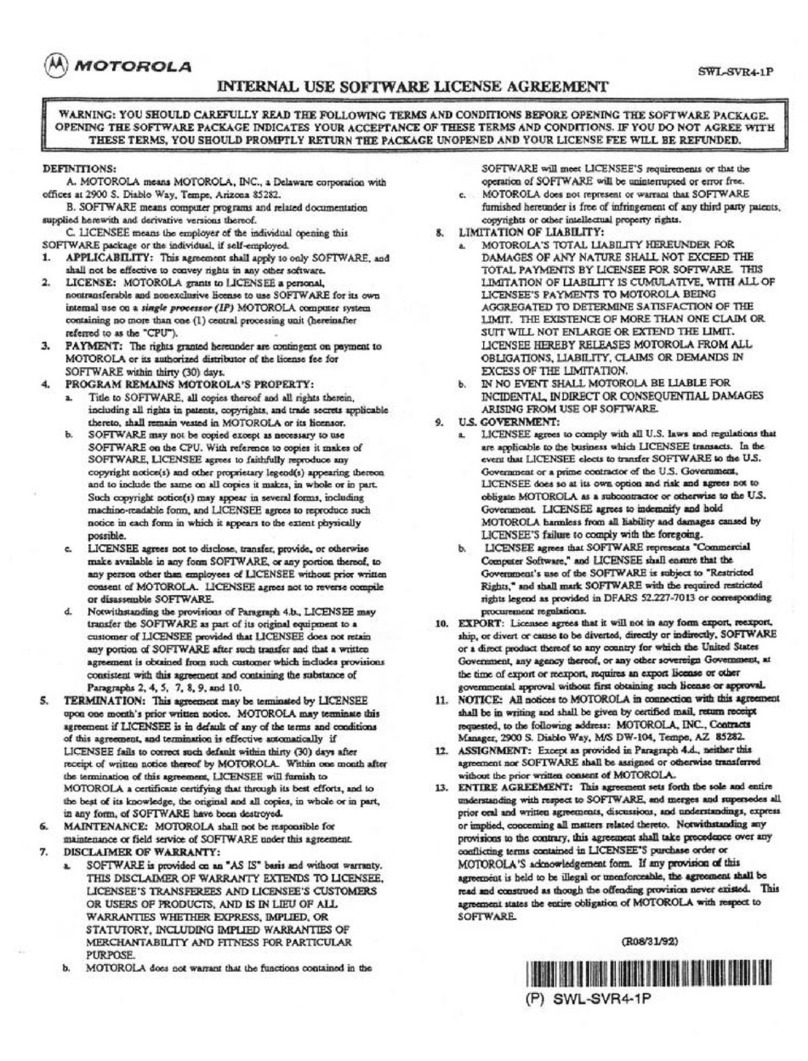
Motorola
Motorola McIAS 1610 Series System manual
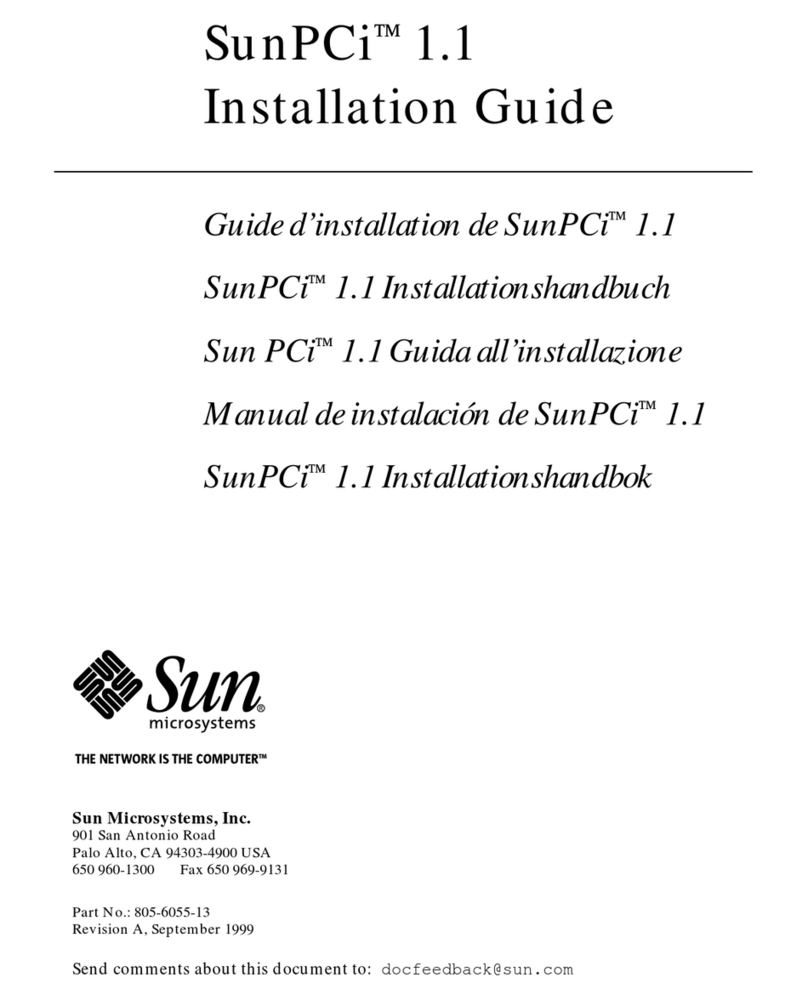
Sun Microsystems
Sun Microsystems SunPCi 1.1 installation guide
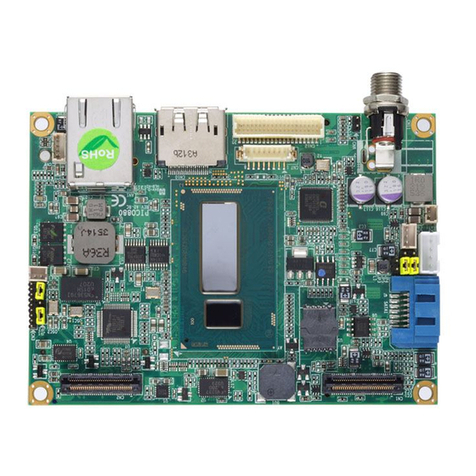
AXIOMTEK
AXIOMTEK PICO880 Series Quick installation guide
NXP Semiconductors
NXP Semiconductors QN902 Series user manual


